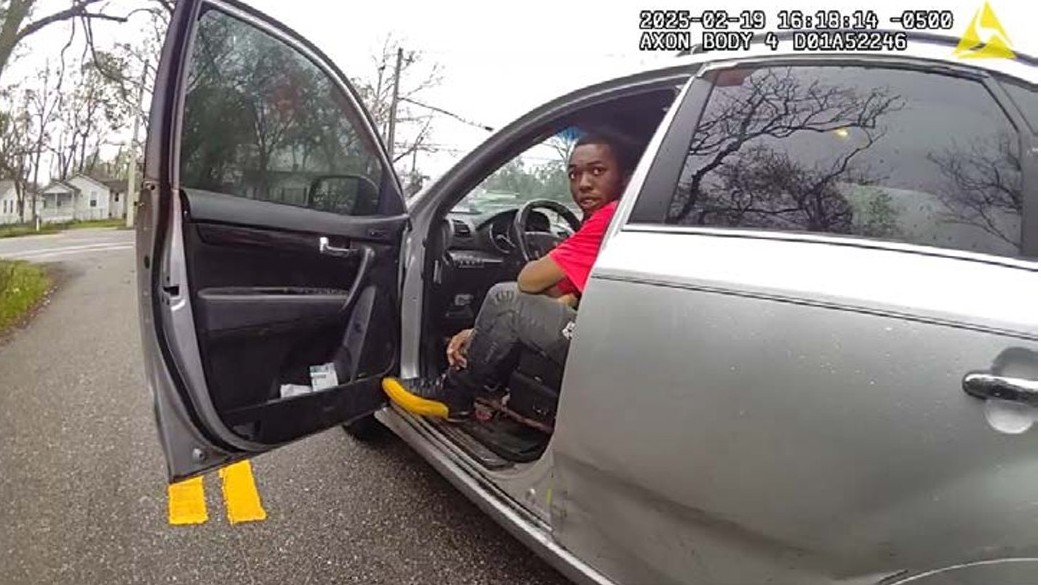The controversial traffic stop of a motorist who refused to open his car door or window to Jacksonville sheriff’s deputies stemmed in part from the department’s vague use-of-force policy, which gives individual officers broad discretion to use violence at the first sign of resistance, according to experts who spoke with The Tributary.
Those experts also unanimously agreed that Officer Donald Bowers should have reported his hit to the face of William McNeil Jr. after he smashed the car’s window to drag McNeil out of the car. That open-handed hit was not disclosed in either the police report or response-to-resistance report Bowers completed after McNeil’s arrest.
Video of McNeil Jr.’s traffic stop in February and arrest went viral this summer, after McNeil released footage taken from his cellphone, which was mounted on his dashboard.
The footage shows Bowers smash McNeil’s window and hit the visibly calm 22-year-old man in the face before unbuckling and dragging him to the ground with the aid of multiple officers called in as backup.
Facing criticism over the dashboard footage, the Jacksonville Sheriff’s Office released Bowers’s bodycam video and argued it contained crucial context that was absent from McNeil’s cellphone footage.
Both Waters and State Attorney Melissa Nelson, whose office cleared Bowers of any criminal wrongdoing during the stop, have lamented what they’ve characterized as disinformation that has spread in the wake of McNeil’s cellphone footage spreading on social media.
“There absolutely was force used by the arresting officers, and yes, that force is ugly,” Sheriff T.K. Waters said when he released the footage. “But as I’ve said many times before, the reality is that all force, all violence, is ugly. And just because force is ugly does not mean it’s unlawful or contrary to policy.”
During the February stop, according to the bodycam video, McNeil refused Bowers’s multiple commands to leave the vehicle. Video shows that, instead, McNeil asked Bowers multiple times to “call your supervisor.”
Bowers also told McNeil he initiated the stop because McNeil was driving in the rain without headlights — a rarely cited infraction, according to traffic data. While bodycam footage shows raindrops on McNeil’s vehicle, it wasn’t raining at the time Bowers bodycam video began.
The Tributary requested any available dashcam footage from Bowers’s vehicle, but the agency said there was none available.
Bowers later told investigators he had another reason for stopping McNeil, which he didn’t reveal during the traffic stop: McNeil was seen leaving an alleged drug house that was under surveillance.
Bowers wrote in a “response-to-resistance” form that he punched McNeil in the face after pulling him out of the vehicle because McNeil “attempted to walk away from officers,” though video footage doesn’t appear to show that.
Left out of Bowers’s report was any mention of an open-handed initial strike he landed on McNeil’s face after breaking the car window. While the hit was clearly shown on McNeil’s own video, the JSO body-camera footage doesn’t clearly show that hit, which Bowers landed just before dragging McNeil out of the SUV.
Bowers told investigators he was trained to use a “distraction strike” in such circumstances, and for that reason, he didn’t think it necessary to list it in his use-of-force report.
The State Attorney’s Office concluded that Bowers, who has more than a dozen commendations in his personnel file, did not commit any crime during the stop. A separate internal review handled by JSO to determine if Bowers broke department policy continues.
Use-of-force policies
The Tributary sent three criminal justice experts a copy of the department’s use-of-force policy, the state attorney’s report and Bowers’s report to review. All agreed that Bowers should have reported the initial “distraction strike.”
Ayesha Bell Hardaway, a professor at Cleveland’s Case Western Reserve University and director of the school’s Social Justice Institute, noted the 26-page policy doesn’t outline reporting requirements until page 25 — and that it seems to require reporting the use of force only when injuries are inflicted.
“Policies are designed to provide officers with instruction on what their obligations are as law enforcement officers, as public employees, and this [policy] didn’t necessarily do that in a cogent way,” she said.
After reviewing the state attorney’s summary of the stop and JSO’s use-of-force policy, Bell Hardaway said she still didn’t understand the justification for Bowers leaving it out of his report.
The policy, she said, stipulates that any use of force that results in an injury must be reported. McNeil suffered a broken tooth, concussion and a traumatic brain injury during the arrest, according to his attorneys.
She and other experts said Bowers’s assertion that the hit was a proper means to an end was irrelevant to whether it had to be reported, since any use of force is presumably tactical.
“The State Attorney’s Office goes through great lengths in their report to sort of justify the officer’s behavior,” she said. “This type of circular logic is exactly how law enforcement avoids being held accountable, and it sends a message to officers that even in instances where the officer may be completely justified in the decision-making, that if they decide to not follow the rules of the policies, there won’t be any consequences.”
Gene Paoline, a criminal justice professor at the University of Central Florida, has studied and compared the use-of-force policies at 662 police departments and presented his and his co-author’s findings at the 2018 International Association of Chiefs of Police meeting in Orlando.
JSO’s policy, he said, does not require that every single instance of force be reported, unless a stun gun, pepper spray or firearm was used. However, there’s no standard for how to write a use-of-force policy, and they vary by department.
For example, Paoline said Orlando has a much stricter threshold for when officers must report any level of force than Jacksonville does. Some departments, he said, consider handcuffing a suspect a type of force.
Given the stricter threshold, it could give the false impression that Orlando police use force much more often than Jacksonville does simply because of its reporting requirements.
“This policy definitely gives you the leeway to use multiple types of force as soon as the person shows any kind of resistance,” he said of JSO’s standard.
Unlike many other departments, JSO does not have a “use-of-force continuum” rule, which allows officers to use greater levels of force in proportion to the level of violence used by a suspect. The continuum gives cops more direction than JSO’s policy, which instead “basically lets the officer use their own discretion,” Paoline said.
In a 2023 interview with The Tributary — conducted in the wake of a different controversial and violent arrest — Undersheriff Shawn Coarsey said JSO’s policy falls in line with Florida Department of Law Enforcement standards, which he said stopped recommending a use-of-force continuum about a decade ago.
JSO did not respond to a request for an interview about the handling of McNeil’s traffic stop except to ask which quotes The Tributary planned to use from the 2023 interview with Coarsey.
Jacksonville uses an “objective reasonableness model,” which is a standard that focuses on whether another officer in the same situation would have believed the use of force was justified, considering the information available to officers at the time force was used.
In 2020, the Florida Police Chiefs Association convened a subcommittee on accountability and societal change that released recommendations on use-of-force policies, which included input from nine Florida police chiefs.
The finalized report said that either objective reasonableness or a continuum is an acceptable standard for policies, as long as they are “properly drafted.” When the report was published, there was about a 50/50 split of Florida departments regarding which model is used.
Mike Benza, another Case Western Reserve University professor, said he didn’t see any issues with how the Jacksonville policy is written — but he agreed the “discretionary strike” Bowers landed on McNeil should’ve been reported. He also questioned whether the strike was reasonable.
“The Fourth Amendment says that officers are only allowed to use the amount of force necessary to either protect themselves or protect others or to conduct their lawful business,” he said, emphasizing that the state attorney’s investigation — which looks for potential crimes — is separate from the department’s investigation into policy violations.
Bell Hardaway added that the Jacksonville policy “goes to great lengths to create cover for officers to use force without specifically identifying the philosophy of the principles behind the use of force.”
How JSO reviews cases
JSO rarely finds that its officers have violated the use-of-force policy.
For example, in 2022, JSO opened 125 investigations into allegations of unnecessary use of force. Of those, 108 allegations did not move past an initial review. Of the 17 that did, none of the allegations were sustained, according to the department’s data.
In 2024, there were 135 allegations of unnecessary use of force and two complaints were sustained.
Coarsey, addressing the 2022 numbers, said every use-of-force incident is heavily reviewed, a process that involves the officer’s direct supervisor, the watch commander and then the professional oversight unit, which is separate.
“If there’s something that is either out of policy, or in question, or maybe needs to be looked at by internal affairs or the integrity unit, then it goes up the chain, all the way to the director,” Coarsey said. “He then decides if it will go to the response to resistance board, or if it’s going to integrity. So there are a lot of eyes that look at every single report.”
In that 2023 conversation, Coarsey admonished a journalist with The Tributary for using the term “beat” in a story that described the actions of multiple officers who kicked and punched a 28-year-old man 17 times after he ran away from a traffic stop. The man, Le’Kien Woods, suffered a closed head injury, a ruptured kidney and reportedly peed blood as a result of the arrest, according to his attorneys.
“If you’re going to be factual, and you want to put it out there to the people in this county, what the facts are, it’s less than 1%,” Coarsey said regarding how often force is used during police contacts with the public in 2023. “It’s 2% of people that are arrested.”
According to JSO’s data, that percentage of use of force against people who were arrested rose to 3% in 2024.
This story is published through a partnership between Jacksonville Today and The Tributary.







